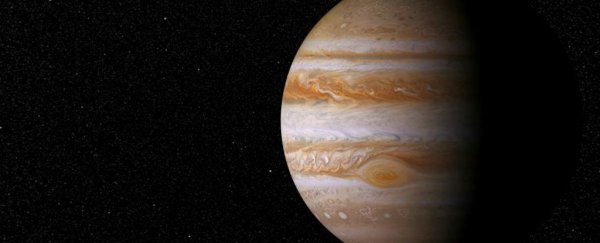The largest planet in our Solar System is about to hit peak brightness, as Jupiter and its four biggest moons are expected to become fully illuminated by the Sun on the evening of Tuesday 8 March.
At 4am US Central Time, or from midnight onwards in Australia, Earth will pass between the Sun and Jupiter, placing Jupiter opposite the Sun in our sky and causing it to shine brighter than at any other time in the next 13 months.
"This means the gas giant is both at its closest point to the Earth as well as fully illuminated by the Sun from our point of view," astronomer Alan Duffy from Swinburne University in Australia told Australian Geographic. "These effects together will ensure that Jupiter is looking its best."
The event is referred to as when Jupiter reaches 'opposition', and this will bring it to its closest point from Earth in 2016. The huge, gassy planet is expected to come within 664 million kilometres (413 million miles) of our planet on the night of March 8, as it rises in the east around sunset, climbs highest in the sky at midnight, and sets in the west around sunrise in the Northern Hemisphere.
You might struggle to see it with the naked eye, so be sure to brush off your binoculars and head somewhere really dark for the best chance of spotting it and its four biggest moons, also known as the Galilean satellites. If you stand with your back to where the Sun sets, Jupiter will be the brightest point in the sky.
"It will also be easily the brightest object in the night sky after Venus sets along with the Sun," says Duffy, "so Jupiter should be easy to see rising on the opposite side of the sky from the setting Sun."
If you have a good backyard telescope, you should be able to make out the shadows cast by Jupiter's moons on the tops of its clouds, and if you can get yourself to an observatory, depending on Jupiter's spin, you might even get a front-seat view of its most incredible feature - the Great Red Spot.
At three times the width of Earth, people have been observing this phenomenon for over 300 years, making it the largest and longest lasting storm in the Solar System - that we know of.
You'll also be able to see its cloud streams, that appear as alternating light and dark bands running along the entire planet. "The dark bands are called 'belts' and the light bands 'zones'," says Geoff Gaherty at Space.com. "Normally at least two belts are visible, but on nights with steady skies, eight or more belts may be seen."
To find out more about Jupiter in the lead-up to its opposition, check out this awesome run-down by astronomer Phil Plait, and happy sky-watching!
